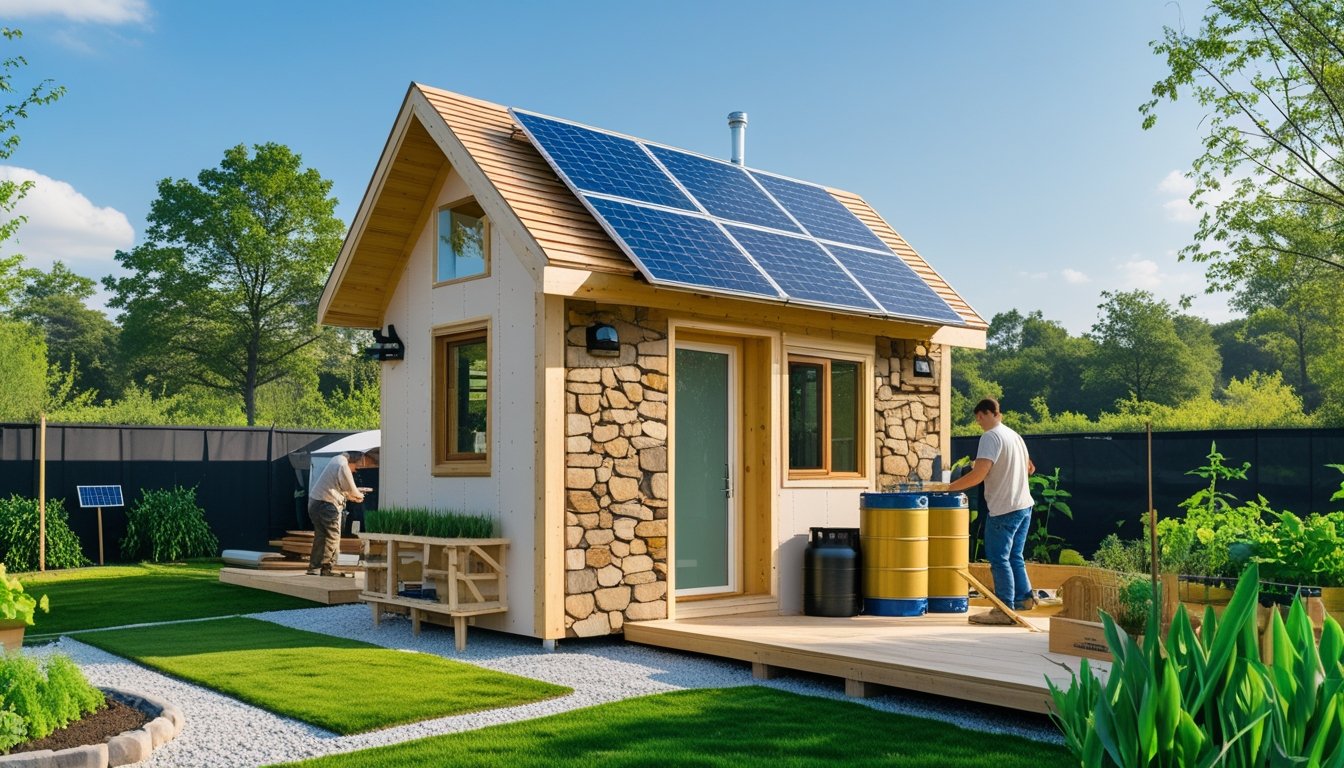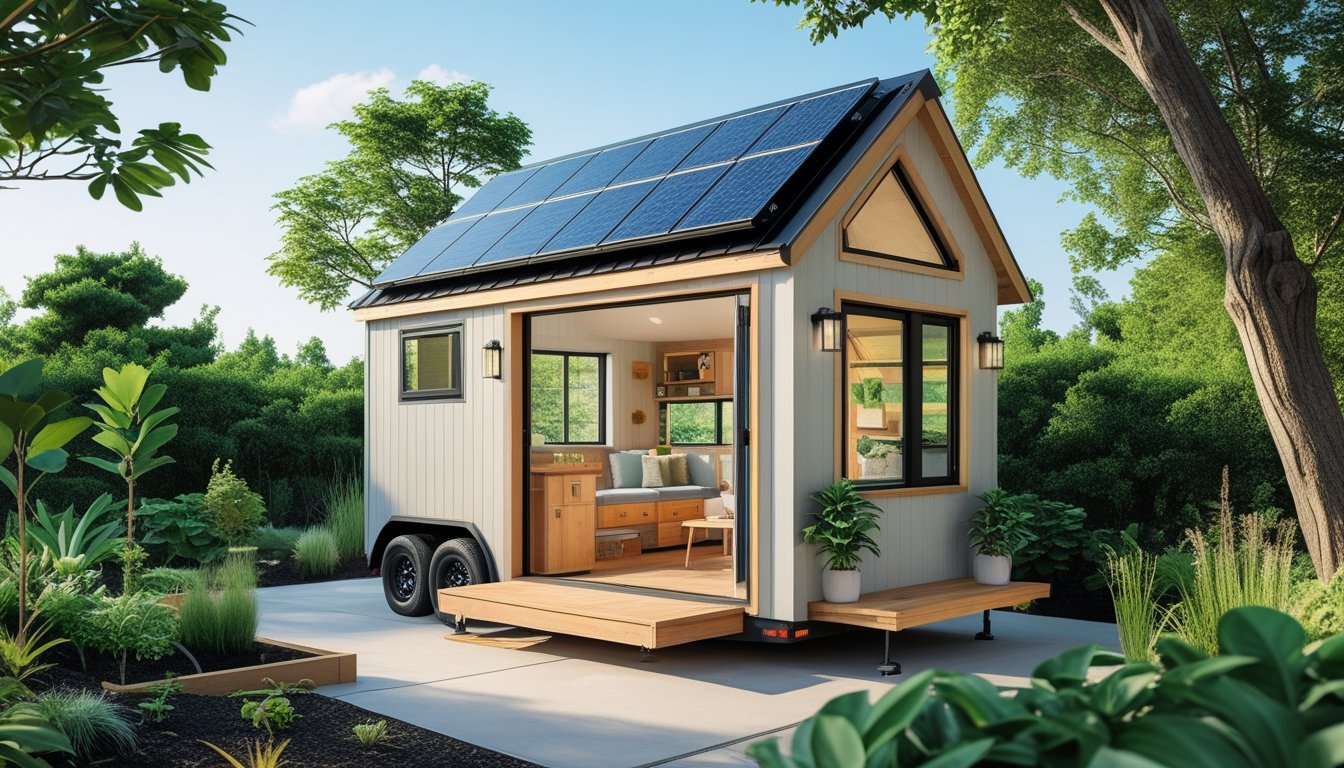Late updated: 08 Jun 2025 12:06
Written by: Sarah Hollister
Building an Eco-Friendly Tiny Home: Sustainable Living Solutions
Building an eco-friendly tiny home is more than a trend; it's a commitment to sustainable living that combines minimalism with environmental consciousness. By embracing smaller living spaces, we not only reduce our carbon footprint but also gain a deeper appreciation for resource efficiency. One of the most vital steps in creating an eco-friendly tiny home is integrating renewable energy systems such as solar panels and utilising sustainable materials like hemp.

As we explore the world of eco-friendly tiny homes, we must consider how to optimise comfort and practicality without sacrificing sustainability. Good ventilation and moisture control are crucial to maintaining a healthy living environment in such compact spaces. With thoughtful design and careful planning, we can ensure that our tiny homes are not just functional but also nurturing spaces that reflect our commitment to living lightly on the Earth.
Engaging with this lifestyle may raise questions about the intricacies of designing and building a tiny home. As we address these frequently asked questions, we equip ourselves with the necessary knowledge and inspiration needed to embark on this unique journey towards eco-friendly living.
Key Takeaways
- Eco-friendly tiny homes use renewable energy and sustainable materials.
- Proper ventilation and design are essential for comfort and health.
- Understanding FAQs helps in making informed decisions.
Essential Elements of Building an Eco-Friendly Tiny Home

Creating an environmentally conscious tiny home involves several critical elements. Sustainable design, eco-friendly materials, and efficient energy and water management play vital roles.
Sustainable Design Principles
Sustainable design is about creating spaces that are energy-efficient and environmentally friendly. In tiny homes, this means maximising the use of space while minimising waste. Minimalism is key, as it reduces the clutter and encourages mindful living.
We emphasise passive solar design, which utilises the home's orientation to regulate temperature naturally. Additionally, incorporating passive heating and cooling systems limits the need for artificial climate control. Thoughtful window placement can increase natural light, reducing the requirement for additional lighting.
Choosing Eco-Friendly Building Materials
An eco-friendly tiny home starts with the right building materials. We focus on using sustainable building materials like reclaimed wood and recycled materials such as steel. These resources, being renewable and repurposed, significantly lower the environmental footprint.
Reclaimed wood adds character and reduces demand for new lumber. Recycled steel offers durability and lowers carbon emissions compared to traditional materials. Utilising recycled materials not only conserves resources but also promotes waste reduction.
Energy Efficiency and Renewable Power
Tiny homes benefit from energy-efficient designs and renewable energy sources. The installation of solar panels is an effective way to harness renewable energy, such as solar power. This provides electricity while decreasing reliance on non-renewable sources.
Incorporating LED lighting throughout the home results in lower energy usage. Energy efficiency is further achieved through effective insulation, which keeps the home warm in winter and cool in summer. By investing in high-performance windows and appliances, we reduce the overall energy consumption.
Water Conservation and Waste Management
In the realm of tiny homes, water conservation is paramount. We can install a rainwater collection system to utilise natural precipitation and integrate greywater systems that recycle water for non-drinking purposes. Low-flow fixtures minimise water use without sacrificing performance.
Addressing waste management, composting toilets offer an eco-friendly alternative to traditional plumbing. These toilets reduce water usage and transform waste into compost, supporting sustainability. By managing water and waste responsibly, we significantly lessen the environmental impact of tiny homes.
Optimising Comfort, Health, and Practicality in Eco-Friendly Tiny Homes

In the creation of a sustainable tiny home, it is paramount to enhance comfort, prioritise health, and maintain practicality. This involves focusing on eco-friendly insulation, energy-efficient appliances, integrating outdoor spaces, and considering legal and budgetary factors.
Eco-Friendly Insulation and Indoor Air Quality
Using eco-friendly insulation is vital in controlling the temperature and improving indoor air quality. Materials such as sheep's wool, cork, and hemp offer excellent thermal properties and are biodegradable. They help in maintaining a comfortable environment by minimising external temperature fluctuations.
Indoor air quality can be enhanced with effective ventilation systems. A well-designed ventilation system can prevent the build-up of pollutants and moisture, creating a healthy indoor environment. This is essential in small spaces where air circulation is crucial. Mechanical ventilation with heat recovery (MVHR) systems can provide fresh air continuously without losing heat energy.
Selecting Energy-Efficient Appliances and Features
Energy-efficient appliances reduce electricity consumption and enhance sustainability. Devices such as induction cooktops, on-demand water heaters, and low-energy refrigerators top the list. They use less power and can operate efficiently even on solar power. LED lighting should be a standard feature. It does not only conserve energy but also lasts longer.
Incorporating smart home technologies allows for better energy management. Smart thermostats and automated lighting systems ensure appliances are used only when needed, contributing to energy conservation.
Outdoor Integration and Landscaping
Integrating outdoor spaces and landscaping is crucial in maximising the functionality of a tiny home. Native plants should be chosen for landscaping as they require less water and maintenance, adapting well to the local climate. A small herb or vegetable garden can provide fresh produce and enhance self-sufficiency.
Utilising outdoor areas as extensions of living spaces can increase overall livability. This might include small decks, patios, or rooftop gardens, which provide space for relaxation and entertainment without increasing the home’s footprint.
Legal, Budgetary and Lifestyle Considerations
Navigating zoning laws and building codes is key when constructing a tiny home. These requirements vary widely, so we must thoroughly research regulations in our area. Compliance ensures that the home is legally recognised, facilitating access to amenities and reducing issues with local authorities.
From a financial perspective, setting a realistic budget is crucial. While tiny homes can offer financial freedom through reduced living costs, initial investment in sustainable materials and energy-efficient systems may be higher. Consider our preferences and lifestyle necessities to balance comfort and cost. Conducting a cost-benefit analysis assists in ensuring we make informed financial decisions.
Frequently Asked Questions
We explore key aspects of constructing eco-friendly tiny homes, addressing costs, best practices, energy options, and more. This information helps guide us through the journey of sustainable tiny house living.
How much does it typically cost to construct an environmentally friendly tiny house?
The cost of building an eco-friendly tiny home can vary significantly based on materials and design complexity. On average, it ranges from £15,000 to £50,000. Utilising recycled materials and doing some work ourselves can help reduce expenses.
What are the best practices for building a sustainable tiny house?
Using sustainable materials like bamboo or repurposed timber ensures longevity and eco-friendliness. Incorporating proper insulation and good ventilation maintains air quality and energy efficiency. These practices support a healthier living environment.
Which renewable energy sources are most efficient for tiny homes?
Solar panels are one of the most efficient renewable energy solutions for tiny homes due to their adaptability. Wind turbines and small-scale hydropower systems can also be effective, depending on the location and climate.
How do tiny homes contribute to a minimalist way of living?
Tiny homes promote minimalism by reducing living space and encouraging us to prioritise essential possessions. This lifestyle fosters conscious consumption and reduces both our ecological footprint and clutter.
What factors should one consider when choosing a location for an eco-friendly tiny home?
Understanding local building codes and zoning laws is crucial when selecting a location. Access to sunlight for solar energy, proximity to essential services, and alignment with our lifestyle preferences should also be considered.
Are there any financial incentives or subsidies available for building eco-friendly tiny homes?
Depending on our location, incentives may be available for sustainable building practices, such as grants or tax credits. Checking with local government agencies can provide information on specific programmes and support for green initiatives.
